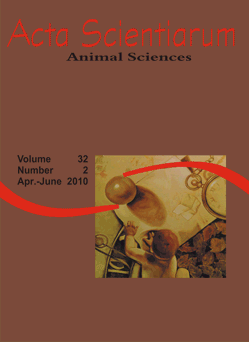<b>Nutritional evaluation and performance of cassava root silage with or without whole soybean in swine diets</b> - doi: 10.4025/actascianimsci.v32i2.8055
Keywords:
alternative foods, starch, performance, digestibility, energy values
Abstract
Two experiments were carried out to determine the nutritional value and performance of growing and total-period swine fed cassava root silage with or without whole soybean. In the first group, 15 crossbred swine were used, in a completely randomized design with parcels (animals) subdivided in time (subparcels) with five treatments and six replications. The study evaluated cassava root silage (CA), cassava root silage with inoculant (CI), cassava root silage + whole soybean (CS) and cassava root silage + whole soybean with inoculant (CSI). The silage showed good nutritional results and inoculant use was not effective in improving nutrient digestibility. In the second group, 36 crossbred swine were used, distributed in three treatments in a completely randomized design, with six experimental units and two piglets per experimental unit. The treatments consisted of basal corn and soybean meal diet (CD), two diets with total corn replacement by CA and CS. For the growth phase, feed:gain ratio was better with the silages. It was concluded that the use of cassava silage with or without inclusion of whole soybean shows good nutritional results, and CA and CS may totally replace corn in diets of growing and finishing swine.Downloads
Download data is not yet available.
Published
2010-07-02
How to Cite
Furlan, A. C., Moreira, I., Toledo, J. B., Carvalho, P. L. O., & Scapinello, C. (2010). <b>Nutritional evaluation and performance of cassava root silage with or without whole soybean in swine diets</b> - doi: 10.4025/actascianimsci.v32i2.8055. Acta Scientiarum. Animal Sciences, 32(2), 155-161. https://doi.org/10.4025/actascianimsci.v32i2.8055
Issue
Section
Nonruminant Nutrition
DECLARATION OF ORIGINALITY AND COPYRIGHTS
- I Declare that current article is original and has not been submitted for publication, in part or in whole, to any other national or international journal.
The copyrights belong exclusively to the authors. Published content is licensed under Creative Commons Attribution 4.0 (CC BY 4.0) guidelines, which allows sharing (copy and distribution of the material in any medium or format) and adaptation (remix, transform, and build upon the material) for any purpose, even commercially, under the terms of attribution.
Read this link for further information on how to use CC BY 4.0 properly.
0.9
2019CiteScore
29th percentile
Powered by 








































